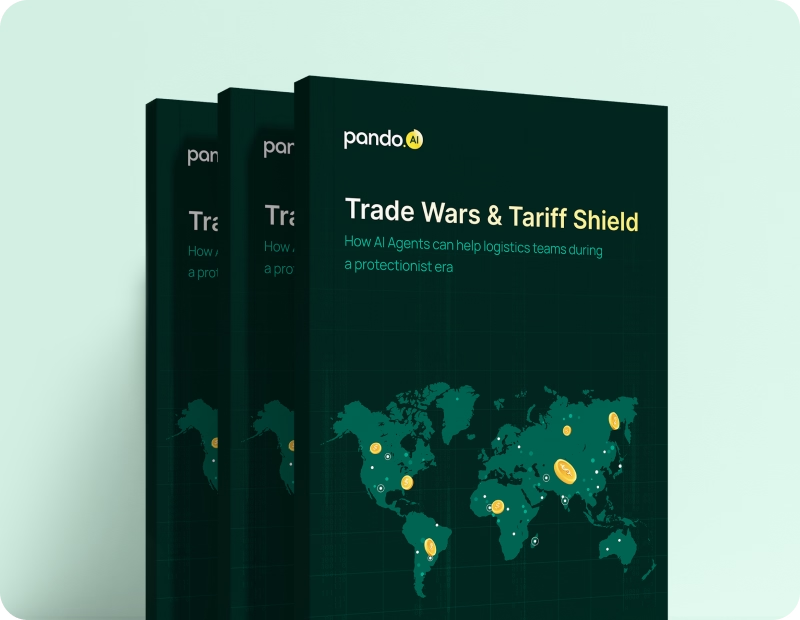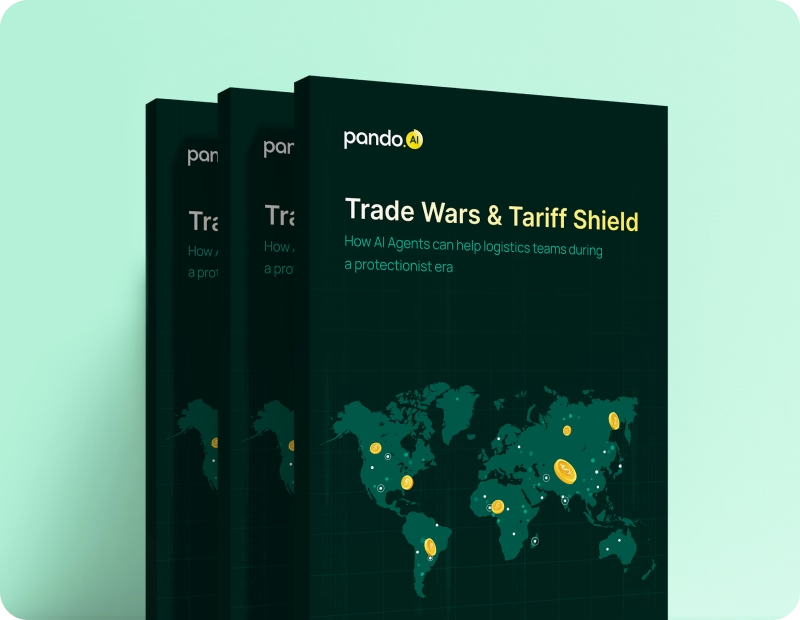-
Products Products
- Industry
- Initiatives
- Resources
- Company
- Book a demo

Before you go: Logistics leaders just dropped the truth on AI
The State of AI in Logistics 2025 is here — no hype, just real conversations and raw insights.
The next leap in logistics: How AI agents redefine international Transportation Management Systems
Smart AI agents transform your global supply chain from a reactive burden to a competitive advantage by revolutionizing transportation management.
Published on January 31, 2025 • 7 mins read
Durga Pratiha

Smart AI agents transform your global supply chain from a reactive burden to a competitive advantage by revolutionizing transportation management.
In April 2021, heavy fog brought China's Qingdao port to a standstill, leaving many container vessels stranded in the Yellow Sea. Events like these highlight the growing need for proactive logistics strategies. AI-powered transportation management systems can analyze weather patterns, port conditions, and real-time data to reroute shipments before disruptions escalate, ensuring supply chain continuity even in unpredictable scenarios.
Supply chain disruptions, from capacity shortages to regulatory bottlenecks, can take many forms and make it harder for businesses to maintain smooth operations. Conventional transportation management systems struggle to keep up, relying on outdated processes that react to problems instead of preventing them.
AI agents change the game by continuously analyzing real-time data across multiple variables, including shipment schedules, carrier performance, geopolitical risks, and more. They identify risks early, optimize routes dynamically, and automate decisions that would otherwise require manual intervention. This shift from reactive to proactive logistics management gives businesses greater control over their operations.
In this comprehensive guide, we'll explore how AI agents are redefining international transportation management, examining real-world applications, and the tangible benefits they bring to global supply chains. From predictive analytics to autonomous decision-making, discover how these intelligent systems are turning supply chain complexity from a liability into a competitive advantage.
Why AI agents are the future of international TMS
Transportation management is facing unprecedented challenges. Carriers now require 48-hour booking windows instead of the conventional two-week timeframe, while customers expect real-time estimated arrival times (ETAs). At the same time, operations teams are struggling to manage increasingly complex decisions. The financial impact of poor transportation management is considerable, with disruptions leading to significant losses. Here’s why:
-
Multi-modal complexity
Today's transportation networks span oceans, rails, roads, and air, creating intricate webs of interdependent movements. Your spreadsheet-based planning tools and rule-based routing systems treat each mode in isolation, missing crucial opportunities for optimization. When spot rates fluctuate hourly and fuel surcharges change daily, these rigid systems lock you into suboptimal decisions. The cost impact is significant—global shippers face substantial losses due to poor modal integration and timing decisions. Inefficiencies in route planning, misalignment between transport modes, and delays add up, ultimately driving up transportation costs. Each planning decision cascades through your network, affecting not just immediate shipment costs but also detention fees, inventory carrying costs, and ultimately, your market competitiveness.
-
Real-time visibility
The promise of end-to-end visibility remains unfulfilled. Your Electronic Data Interchange (EDI) feeds, manual tracking updates, and disconnected carrier portals create a fragmented picture of your supply chain. This fragmentation isn't just an operational headache – it's a compliance nightmare. As regulatory requirements grow more complex across borders, your teams struggle to maintain accurate documentation and customs compliance. A single missing document or delayed update can trigger cargo holds, resulting in penalties that reach hundreds of thousands of dollars. Moreover, this visibility gap creates a chasm between long-haul transportation and last-mile delivery, making it impossible to meet increasingly demanding customer delivery windows that have shrunk from days to hours.
-
Disruption management
When disruptions hit, your existing systems reveal their greatest weakness: they can only execute pre-planned scenarios using outdated cost assumptions. While real-time spot rates offer potential savings during disruptions, rigid systems and manual rebooking processes mean you're often forced into premium-rate alternatives. Your teams waste precious hours manually analyzing impacts, researching options, and updating stakeholders – hours during which available capacity disappears and costs skyrocket. The financial impact compounds quickly: expedited shipping premiums, contract penalties, compliance fines, and lost sales opportunities. One major disruption can wipe out an entire quarter's logistics savings. Beyond immediate costs, this constant firefighting pulls resources from strategic initiatives like network optimization and sustainability efforts, making it impossible to drive real supply chain innovation.
How can AI agents transform international TMS?
Your logistics and transportation teams make thousands of complex decisions daily – weighing costs against transit times, balancing capacity across modes, and spotting risks before they become disruptions. Now, AI agents are bringing this sophisticated decision-making to every aspect of transportation management. These autonomous systems process millions of data points per second, learn from every shipment, and take action in real time. While rule-based automation simply follows predefined paths, AI agents adapt and improve, transforming transportation management from a reactive process into a predictive powerhouse.
1. Adaptive shipment creation and orchestration
International shipment documentation demands meticulous coordination across multiple touchpoints. Each consignment requires precise handling of commercial invoices, packing lists, bills of lading, customs declarations, and certificates of origin. Your operations teams manually validate harmonized codes, cross-check quantities, and ensure compliance with destination requirements. One error in documentation triggers customs holds and compliance penalties.
AI agents transform this process by automatically extracting and validating data across documents, ensuring regulatory compliance, and maintaining consistency through mode changes. Where teams once struggled with fragmented processes across ocean, air, and land documentation, they now operate in a unified, error-free environment. Complex multi-modal shipments that previously required hours of cross-checking now flow smoothly through your supply chain.
2. Dynamic and intelligent load planning
Container utilization starts with your load planners facing mounting pressures: maximize space, meet delivery deadlines, maintain cargo compatibility, and adapt to hourly changes in booking forecasts. Standard TMS systems provide only basic volumetric calculations, leaving planners to manually puzzle through complex decisions. As booking windows shrink from weeks to days, this manual approach results in sub-optimal loads, rush expeditions, and missed consolidation opportunities.
AI agents revolutionize this operation by analyzing your entire network in real-time. The system simultaneously evaluates cargo loading patterns, validates cargo compatibility rules, and factors in route-specific constraints. When vessels report overbooking or volumes surge unexpectedly, it instantly recalculates optimal cargo combinations across different routes to maximize efficiency.
What was once a reactive, manual effort transforms into a dynamic optimization engine. Consolidation opportunities are identified days in advance, container utilization improves across your network, and costly last-minute expedited shipments become rare exceptions rather than daily firefighting.
3. Proactive risk and route management
Route optimization in global logistics demands constant recalibration. Your teams evaluate transit time reliability against cost implications, assess carrier performance against service commitments, and manage capacity across terminals. Each routing decision requires validating dozens of parameters—from terminal cut-off times to transshipment connections and inland delivery windows. Manual tracking and updating of these variables lead to suboptimal routing choices and missed savings opportunities.
AI agents transform this complexity by continuously evaluating your entire transportation network. The system analyzes historical carrier performance, monitors container availability (empty returns, depot stock levels, upcoming unloading schedules), and real-time capacity data simultaneously. When service degradation is detected on any lane, it automatically calculates network-wide impact and initiates routing optimization while maintaining all compliance requirements.
The shift from static route assignments to dynamic network optimization redefines transportation planning. Your network continuously adapts to changing conditions, optimal routings are secured before service deteriorates, and your team focuses on strategic network design rather than tactical replanning.
4. Seamless end-to-end visibility
Current visibility challenges stem from fragmented data sources and disconnected systems. Your teams' toggle between carrier portals, port websites, and customs platforms to piece together the shipment status. Updates arrive in different formats, at varying frequencies, creating blind spots in your supply chain. Critical delays often surface only after they've already impacted downstream operations.
AI agents create a unified visibility framework by standardizing and connecting data across your network. The system doesn't just collect updates – it understands relationships between shipments, predicts potential delays using historical patterns, and automatically triggers mitigation actions before disruptions cascade.
Your operation evolves from chasing updates to preventing exceptions. Real-time visibility becomes truly predictive, giving your teams the power to manage by an exception while maintaining perfect clarity across your supply chain network.
Measuring business impact: How AI transforms transportation success
The difference between good and great transportation management directly impacts your bottom line, customer satisfaction, and market position. Organizations implementing AI agents are discovering that the real value isn't in automation alone – it's in the fundamental transformation of what's possible in global logistics.
Execution cost optimization: Conventional transportation management bleeds money through suboptimal routing, last-minute expedited shipments, and poor container utilization. AI agents systematically eliminate these cost leaks. By optimizing routes before issues arise, automatically identifying consolidation opportunities, and maximizing container space, your operation transforms cost centers into value drivers. The days of paying premium rates for rushed shipments become rare exceptions rather than daily necessities.
Transit time performance: Speed to market matters more than ever, but faster transit times traditionally mean higher costs. AI agents break this trade-off. Through proactive optimization and automated documentation processing, shipments move faster without premium charges. The system anticipates bottlenecks, prepares documentation in advance, and maintains flow through your network. Your delivery windows become reliable commitments rather than hopeful estimates.
Enhanced service reliability: Meeting customer commitments in today's volatile market requires more than just good planning. AI agents ensure reliability through predictive disruption management and automated rebooking capabilities. When issues arise, the system instantly evaluates alternatives and executes changes while maintaining compliance. Your on-time delivery performance becomes a consistent achievement rather than a constant challenge.
Operational efficiency: Manual processes don't just consume time - they introduce errors and pull your experts away from strategic work. AI agents transform your operation's efficiency through automated task execution and intelligent compliance management. Documentation accuracy improves while processing time drops dramatically. Your team's shift from data entry and problem-solving to strategic planning and relationship building.
Harnessing AI agents as your competitive advantage
Transportation management is undergoing a major shift, and the old ways of doing things just don’t cut it anymore. AI agents are at the heart of this change, turning logistics from a series of reactive steps into a well-oiled, proactive machine. With AI driving smarter decision-making, everything from route optimization to real-time monitoring becomes easier, faster, and more efficient. Faster deliveries, reduced costs, and better service reliability are now within reach.
That’s where Pando comes in. Imagine having a platform that streamlines your logistics and adapts as your business grows. Pando leverages AI agents to continuously refine operations based on live data, learning from every shipment, every delay, and every challenge. Whether it's optimizing load planning or predicting disruptions, Pando ensures your supply chain is always one step ahead, empowering your team with the insights they need to make decisions that drive performance and reduce inefficiencies.
In a world where efficiency and reliability are critical, Pando is the partner you need to stay ahead. It’s time to unlock the true potential of your supply chain with Pando—where innovation, intelligence, and growth converge to create a logistics operation that’s ready for the future.
Subscribe to Pando blog and Crossroads newsletter now!
Stay up to date with the latest logistics, transportation, and supply chain tips and news.
Subscribe Here!












